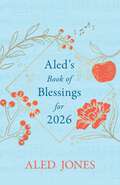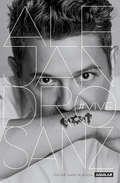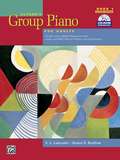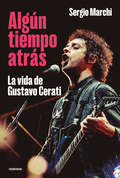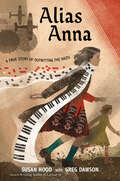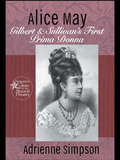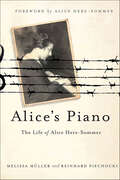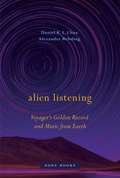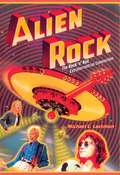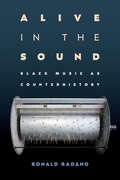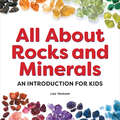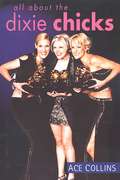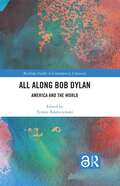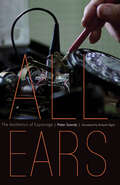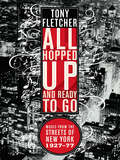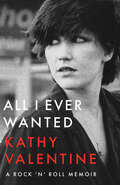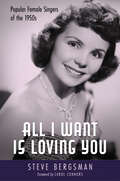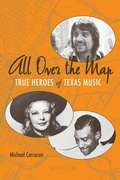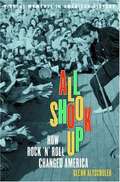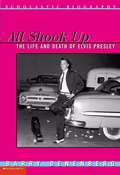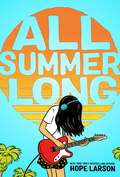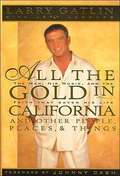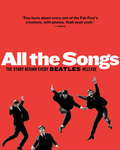- Table View
- List View
Aled’s Book of Blessings for 2026
by Aled JonesDrawing on spiritual wisdom across the ages, from ancient times to the modern day, as well as across diverse cultures, Aled has compiled this Book of Blessings to ground and inspire you each day in 2026 - celebrating special events, anniversaries and fun facts that this year brings.With Aled's friendly stories, anecdotes and unique insight into classical music, he introduces a composer and classical work to inspire us for each month of the year.Charming line drawing illustrations decorate the page and journaling space allows the reader to respond to what they are reading by either making notes or with a drawing of their own.A book that's perfect as a gift for mum or dad, it is perfect to dip in and out of during the year and will be a favourite treasure trove of wisdom for all who love watching Aled on BBC TV or listen to his inspiring show on Classic FM.
Aled’s Book of Blessings for 2026
by Aled JonesDrawing on spiritual wisdom across the ages, from ancient times to the modern day, as well as across diverse cultures, Aled has compiled this Book of Blessings to ground and inspire you each day in 2026 - celebrating special events, anniversaries and fun facts that this year brings.With Aled's friendly stories, anecdotes and unique insight into classical music, he introduces a composer and classical work to inspire us for each month of the year.Charming line drawing illustrations decorate the page and journaling space allows the reader to respond to what they are reading by either making notes or with a drawing of their own.A book that's perfect as a gift for mum or dad, it is perfect to dip in and out of during the year and will be a favourite treasure trove of wisdom for all who love watching Aled on BBC TV or listen to his inspiring show on Classic FM.
Alejandro Sanz. #VIVE
by Óscar García BlesaLa biografía autorizada de Alejandro Sanz, el artista español más influyente de las últimas tres décadas. Alejandro Sanz. #VIVE es un relato colectivo en forma de historia oral del que puede considerarse el artista español más influyente de las últimas tres décadas. Escrita por el experto musical Óscar García Blesa, ejecutivo discográfico que vivió en primera persona el nacimiento del disco MÁS y que comparte una estrecha relación con Alejandro Sanz desde hace más de veinte años, el libro se construye con testimonios de más de doscientas personalidades relevantes en la vida del artista, tanto de su ámbito personal como del mundo de la cultura, política y actualidad nacional e internacional (Joan Manuel Serrat, Penélope Cruz, Rafael Nadal, Jorge Ramos o Alicia Keys, entre otros), incluida la voz del propio Alejandro. Alejandro Sanz. #VIVE conforma el retrato más personal del artista, en una edición sumamente cuidada y con un formato especial. Todo ello apoyado con una selección de fotografías de su archivo personal. #VIVE supone un trabajo que profundiza en la génesis de su álbum MÁS (el disco más vendido de la historia de la música española) y que traza un perfil biográfico a través de las voces de personajes cercanos al artista madrileño. Un puzle con centenares de piezas que desembocan en la banda sonora de Alejandro Sanz. En palabras del propio Alejandro: «Hay canciones que al cerrar los ojos se convierten en personas». A lo largo de sus más de quinientas páginas, familiares y amigos, artistas, políticos, deportistas y otros personajes principales en la vida del cantante junto a las propias reflexiones de Alejandro, sumergen al lector en un viaje que recorrerá sus propias emociones y vivencias dibujando el mapa íntimo y sonoro de varias generaciones.
Alfred's Group Piano For Adults Student Book: An Innovative Method (Alfred's Group Piano For Adults #Book 1)
by E. L. Lancaster Kenon D. RenfrowThe Second Edition of Alfred's Group Piano for Adults Book 1, includes updates inspired by numerous recommendations from group piano teachers and students. This book includes a CD-ROM containing both Audio and General MIDI Files of the 500+ accompaniments included in the text, each with an interesting and engaging arrangement coupled with the piano part. Designed for collegiate non-keyboard music majors with little or no keyboard experience, the easy-to-use text contains 26 units, each intended to be covered in one week, thus fulfilling two semesters or three quarters of study. Theory, technique, sight-reading, repertoire, harmonization, improvisation, and ensemble activities are taught thoroughly and consistently throughout the text.
Algún tiempo atrás. La vida de Gustavo Cerati
by Sergio MarchiLa biografía definitiva de Gustavo Cerati, uno de los músicos argentinos de mayor trascendencia internacional, escrita por uno de los periodistas e historiadores que mejor lo conoció, y que pone en un mismo, exhaustivo tomo, hecho de infinidad de entrevistas y un enorme archivo personal, las distintas dimensiones del hombre y el artista, su recorrido vital, su fuerza creativa y su enorme legado. La perfección es inalcanzable. Sin embargo, Gustavo Cerati la buscó con fuerza y pasión en su arte. En conexión con ese espíritu irreductible, Algún tiempo atrás. La vida de Gustavo Cerati aborda el recorrido vital y creativo del hombre y del artista con la misma conciencia -la de que hay enigmas de imposible resolución- pero sin limitarse jamás en su afanosa investigación. Decidido a recuperar la parte más luminosa de esta figura única, la de uno de los músicos argentinos de mayor proyección internacional, Sergio Marchi no deja rincón sin visitar: en procura tanto del compositor e intérprete que trascendió masivamente con Soda Stereo y luego se reinventó en una extraordinaria carrera solista, como del hijo de una familia trabajadora que -dato que suele olvidarse bajo el prejuicioso mito del "cheto"- llegó desde el interior del país a la Buenos Aires de los 50; del niño travieso, curioso y activo; del adolescente insaciable que conoció la ebullición rockera de los 70; de ese muchacho que supo que habría de hacerse a sí mismo a fuerza de talento y también de trabajo. Del ser enamoradizo que encontró en las mujeres un manantial inagotable de inspiración, mucho amor y no pocos padecimientos; del marido y padre que anheló ser. Del obrero musical que muy poca gente conoció; que experimentó con el rock, el pop, la electrónica, con la tecnología y con sus pelos. Y de la estrella hábil, escurridiza y audaz que lidió con adversidades externas e internas y supo sortear muchas de las trampas de la fama. Del hombre que transitó varias lunas y unas cuantas vidas. En virtud de una investigación minuciosa, una multitud de entrevistas exclusivas a otros artistas, amigos y allegados, y un archivo personal enorme forjado a través de una relación de años que fue un vínculo profesional pero también de afecto y complicidad, Marchi pone en juego las múltiples dimensiones de este hacedor de universos, desbarata algunas falsas creencias y recupera la magia de un personaje a la vez mítico y absolutamente real y sensible, de carne y hueso.
Alias Anna: A True Story of Outwitting the Nazis
by Greg Dawson Susan HoodThe moving true story of how young Ukrainian Jewish piano prodigies Zhanna (alias “Anna”) and her sister Frina outplayed their pursuers while hiding in plain sight during the Holocaust. A middle grade nonfiction novel-in-verse by award-winning author Susan Hood with Greg Dawson (Zhanna’s son).She wouldn’t be Zhanna. She’d use an alias. A for Anna. A for alive.When the Germans invade Ukraine, Zhanna, a young Jewish girl, must leave behind her friends, her freedom, and her promising musical future at the world’s top conservatory. With no time to say goodbye, Zhanna, her sister Frina, and their entire family are removed from their home by the Nazis and forced on a long, cold, death march. When a guard turns a blind eye, Zhanna flees with nothing more than her musical talent, her beloved sheet music, and her father’s final plea: “I don’t care what you do. Just live.” This incredible true story in-verse about sisterhood, survival, and music is perfect for fans of Lifeboat 12, Inside Out and Back Again, and Alan Gratz.Includes extensive back matter with original letters and photographs, additional information, and materials for further reading.
Alice May: Gilbert & Sullivan's First Prima Donna (Forgotten Stars of the Musical Theatre)
by Adrienne SimpsonThis biography tells the story of Alice May, a touring prima donna in the nineteenth century who travelled from England to Australia, New Zealand, India and the US, taking part in pioneering performances of the popular light operas of the day. Along the way she took part in many premieres, including the first production of Gilbert and Sullivan's The Sorcerer and the first authorised American production of The Mikado . This colourful life story will appeal to theatre historians, fans of the melodrama, burlesque, and the musical stage.
Alice's Piano: The Life of Alice Herz-Sommer
by Melissa Müller Reinhard PiechockiThe story of Holocaust survivor and pianist Alice Herz-Sommer: “A miraculous journey of mother and son for whom music provided strength and nourishment.” —Kirkus ReviewsAlice Herz-Sommer was born in Prague in 1903. A talented pianist from a very early age, she became famous throughout Europe. But as the Nazis rose to power, her world crumbled. In 1942, her mother was deported to the Theresienstadt concentration camp and vanished. In 1943, Alice, her husband, and their six-year-old son were sent there, too.In the midst of horror, music, especially Chopin’s Etudes, was Alice’s salvation. Theresienstadt was a “show camp” —a living slice of Nazi propaganda created to convince outsiders that the Jews were being treated humanely. In more than a hundred concerts, Alice gave her fellow prisoners hope in a time of suffering. Written with the cooperation of Alice Herz-Sommer, who contributes a foreword, Melissa Müller and Reinhard Piechocki’s Alice’s Piano is the first time her story has been told.“Most moving is the story throughout of her loving bond with her son and how she saved him. No politics, intolerance, or self-righteousness, no talk of revenge, always the rigor and joy of music.” —Booklist (starred review)Published in the UK as A Garden of Eden in Hell
Alien Listening: Voyager's Golden Record and Music from Earth
by Daniel K. Chua Alexander RehdingAn examination of NASA's Golden Record that offers new perspectives and theories on how music can be analyzed, listened to, and thought about—by aliens and humans alike.In 1977 NASA shot a mixtape into outer space. The Golden Record aboard the Voyager spacecrafts contained world music and sounds of Earth to represent humanity to any extraterrestrial civilizations. To date, the Golden Record is the only human-made object to have left the solar system. Alien Listening asks the big questions that the Golden Record raises: Can music live up to its reputation as the universal language in communications with the unknown? How do we fit all of human culture into a time capsule that will barrel through space for tens of thousands of years? And last but not least: Do aliens have ears?The stakes could hardly be greater. Around the extreme scenario of the Golden Record, Chua and Rehding develop a thought-provoking, philosophically heterodox, and often humorous Intergalactic Music Theory of Everything, a string theory of communication, an object-oriented ontology of sound, and a Penelopean model woven together from strands of music and media theory. The significance of this exomusicology, like that of the Golden Record, ultimately takes us back to Earth and its denizens. By confronting the vast temporal and spatial distances the Golden Record traverses, the authors take listeners out of their comfort zone and offer new perspectives in which music can be analyzed, listened to, and thought about—by aliens and humans alike.
Alien Rock: The Rock 'n' Roll Extraterrestrial Connection
by Michael LuckmanWhether you&’re a UFO skeptic, believer, or merely a rock music fan, Alien Rock takes you on a fascinating and irreverent journey exploring the extraterrestrial stories of your favorite rock icons. From Elvis to the Beatles and from Michael Jackson to Marilyn Manson, countless rock stars have claimed to have seen, communed with, been inspired by, and sometimes even descended from extraterrestrials. Now you can discover these stories for yourself in this illuminating, all-access pass to rock&’s unearthly encounters—some friendly, some frightening, and some frankly bizarre. From John Lennon spying a UFO from his penthouse in 1974 to Jimi Hendrix&’s claim that he was a messenger from &“another place,&” there is no extraterrestrial tale neglected. With witty prose and in-depth research, Alien Rock provides a fascinating new perspective on the long, strange trip that is rock history, and suggests that, wherever the road takes us, we may not be traveling alone.
Alive in the Sound: Black Music as Counterhistory (Refiguring American Music)
by Ronald RadanoIn Alive in the Sound, Ronald Radano proposes a new understanding of US Black music by focusing on the key matter of value, manifested musically in its seemingly embodied qualities—spirit, soul, and groove. While acknowledging these qualities are always embedded in Black music, Radano shows they developed not simply from performance but from musicians’ status as laborers inhabiting an enduring racial-economic contradiction: Black music originated publicly as an exchangeable property owned by people whose subhuman status granted them—as “natural” musicians—indelible properties of sound. As a contradiction of the rules of ownership, wherein enslaved property was forbidden the right to own, modern Black music emerges after emancipation as a primary possession, moving dialectically into commercial markets and counterhistorically back into Black worlds. Slavery’s seminal contests of ownership underlie modern musical sensations of aliveness, which become the chief measure of value in popular music. By reconceiving US Black music history as a history of value, Radano rethinks the music’s place in US and global culture.
All About Rocks and Minerals: An Introduction for Kids
by Lisa TrusianiDig in to a fun first look at rocks and gems for kids ages 3 and up From tiny pebbles to huge mountains, rocks are everywhere! And young rockhounds can explore them with All About Rocks and Minerals. It's packed full of fascinating facts and photos that introduce kids to 50 impressive stones. They'll discover what each one looks like, what makes it unique, and more.The life of a rock—Start with a brief introduction that explains how rocks are formed, the 3 types of rock, and the difference between rocks, minerals, and crystals.Big, beautiful images—Colorful pictures let kids get up close and personal with all kinds of awesome rocks and gems.Amazing rock facts—Did you know that there's a special stone for the month you were born? Or that sailors believed aquamarine would protect them at sea?Give curious kids an exciting introduction to geology with this rocks and minerals book for kids.
All About the Dixie Chicks
by Ace CollinsJust two short years ago, The Dixie Chicks were practically unheard-of outside of Texas, but today, they're the hottest act in country music. The explosive popularity of their album Wide Open Spaces has rocketed the Chicks to the top of the charts, and in the last year alone, they have won three Grammys (Best Country Album, Best New Artist and Best Country performance by a duo or group with vocal), two Country Music Association awards and an American Music Award. Their new album is expected to do even better. Now, veteran country music writer Ace Collins has captured their whole inspiring story, from their early days playing to loyal fans in Dallas, right up to their current success and thrilling future!
All Along Bob Dylan: America and the World (Routledge Studies in Contemporary Literature)
by J. Roger KurtzAll Along Bob Dylan: America and the World offers an important contribution to thinking about the artist and his work. Adding European and non-English speaking contexts to the vibrant field of Dylan studies, the volume covers a wide range of topics and methodologies while dealing with the inherently complex and varied material produced or associated with the iconic artist. The chapters, organized around three broad thematic sections (Geographies, Receptions and Perspectives), address the notions of audience, performance and identity, allowing to map out the structure of feeling and authenticity, both, in the case of the artist and his audience. Taking its cue from the collapse of the so-called high-/ low culture split following from the Nobel Prize, the book explores the argument that Dylan (and all popular music) can be interpreted as literature and offers discussions in the context of literary traditions, or visual culture and music. This contributes to a nuanced and complex portrayal of the seminal cultural phenomenon called Bob Dylan.
All Ears: The Aesthetics of Espionage
by Peter SzendyThe world of international politics has recently been rocked by a seemingly endless series of scandals involving auditory surveillance: the NSA’s warrantless wiretapping is merely the most sensational example of what appears to be a universal practice today. What is the source of this generalized principle of eavesdropping?All Ears: The Aesthetics of Espionage traces the long history of moles from the Bible, through Jeremy Bentham’s “panacoustic” project, all the way to the intelligence-gathering network called “Echelon.” Together with this archeology of auditory surveillance, Szendy offers an engaging account of spycraft’s representations in literature (Sophocles, Shakespeare, Joyce, Kafka, Borges), opera (Monteverdi, Mozart, Berg), and film (Lang, Hitchcock, Coppola, De Palma). Following in the footsteps of Orpheus, the book proposes a new concept of “overhearing” that connects the act of spying to an excessive intensification of listening. At the heart of listening Szendy locates the ear of the Other that manifests itself as the originary division of a “split-hearing” that turns the drive for mastery and surveillance into the death drive.
All Hopped Up and Ready to Go: Music from the Streets of New York 1927-77
by Tony FletcherA penetrating and entertaining exploration of New York's music scene from Cubop through folk, punk, and hip-hop. From Tony Fletcher, the acclaimed biographer of Keith Moon, comes an incisive history of New York's seminal music scenes and their vast contributions to our culture. Fletcher paints a vibrant picture of mid-twentieth-century New York and the ways in which its indigenous art, theater, literature, and political movements converged to create such unique music. With great attention to the colorful characters behind the sounds, from trumpet player Dizzy Gillespie to Tito Puente, Bob Dylan, and the Ramones, he takes us through bebop, the Latin music scene, the folk revival, glitter music, disco, punk, and hip-hop as they emerged from the neighborhood streets of Harlem, the East and West Village, Brooklyn, the Bronx, and Queens. All the while, Fletcher goes well beyond the history of the music to explain just what it was about these distinctive New York sounds that took the entire nation by storm.
All I Ever Wanted: A Rock 'n' Roll Memoir
by Kathy Valentine&“Recounts in vivid detail the gloriously debauched path of the Go-Gos through early rock success . . . and the darkness that such freedom can breed.&” —Los Angeles Times Runner-up, Carr P. Collins Award for Best Book of Non-Fiction At twenty-one, Kathy Valentine was at the Whisky in Los Angeles when she met a guitarist from a fledgling band called the Go-Go&’s and the band needed a bassist. The Go-Go&’s became the first multi-platinum-selling, all-female band to play instruments themselves, write their own songs, and have a number one album. Their debut, Beauty and the Beat, spent six weeks at the top of the Billboard 200 and featured the hit songs &“We Got the Beat&” and &“Our Lips Are Sealed.&” The record&’s success brought the pressures of a relentless workload and schedule culminating in a wild, hazy, substance-fueled tour that took the band from the club circuit to arenas, where fans, promoters, and crew were more than ready to keep the party going. All I Ever Wanted traces the path that took Valentine from her childhood in Texas—where she all but raised herself—to the height of rock n&’ roll stardom, devastation after the collapse of the band that had come to define her, and the quest to regain her sense of self after its end. Valentine also speaks candidly about the lasting effects of parental betrayal, abortion, rape, and her struggles with drugs and alcohol—and the music that saved her every step of the way. &“An epic tour of honest storytelling. All I Ever Wanted is a raw look at the highs and lows of being high and low. Long live the Go-Gos!&” —Amy Poehler
All I Ever Wanted: A Rock 'n' Roll Memoir
by Kathy Valentine&“Recounts in vivid detail the gloriously debauched path of the Go-Gos through early rock success . . . and the darkness that such freedom can breed.&” —Los Angeles Times Runner-up, Carr P. Collins Award for Best Book of Non-Fiction At twenty-one, Kathy Valentine was at the Whisky in Los Angeles when she met a guitarist from a fledgling band called the Go-Go&’s and the band needed a bassist. The Go-Go&’s became the first multi-platinum-selling, all-female band to play instruments themselves, write their own songs, and have a number one album. Their debut, Beauty and the Beat, spent six weeks at the top of the Billboard 200 and featured the hit songs &“We Got the Beat&” and &“Our Lips Are Sealed.&” The record&’s success brought the pressures of a relentless workload and schedule culminating in a wild, hazy, substance-fueled tour that took the band from the club circuit to arenas, where fans, promoters, and crew were more than ready to keep the party going. All I Ever Wanted traces the path that took Valentine from her childhood in Texas—where she all but raised herself—to the height of rock n&’ roll stardom, devastation after the collapse of the band that had come to define her, and the quest to regain her sense of self after its end. Valentine also speaks candidly about the lasting effects of parental betrayal, abortion, rape, and her struggles with drugs and alcohol—and the music that saved her every step of the way. &“An epic tour of honest storytelling. All I Ever Wanted is a raw look at the highs and lows of being high and low. Long live the Go-Gos!&” —Amy Poehler
All I Want Is Loving You: Popular Female Singers of the 1950s (American Made Music Series)
by Steve BergsmanIn All I Want Is Loving You: Popular Female Singers of the 1950s, author Steve Bergsman focuses on the white, female artists of the 1950s, a time that predated the chart-topping girl groups of the early 1960s. These popular performers, many of whom graduated out of the big bands of the 1940s, impacted popular music in a huge way. As the last bastion of traditional pop and the last sirens of swing, they undeniably shined in the spotlight. Yet these singers’ fame dimmed relatively quickly with the advent of rock ’n’ roll. A fortunate few, like Doris Day, Patti Page, Peggy Lee, and Debbie Reynolds, experienced some of their biggest hits in the late 1950s, and Eydie Gormé broke out in the 1960s. The luckiest, including Dinah Shore and Rosemary Clooney, ventured to television with varying degrees of success. Others would become major attractions at nightclubs in Las Vegas or, like Teresa Brewer, shift into the jazz world.Though the moment did not last, these performers were best-selling singers, darlings of the disk jockeys, and the frenetic heartbeat of fan clubs during their heyday. In a companion volume, Bergsman has written the history of African American women singers of the same era. These Black musicians transitioned more easily as a new form of music, rock ’n’ roll, skyrocketed in popularity. In both books, Bergsman reintroduces readers to these talented singers, offering a thorough look at their work and turning up the volume on their legacy.
All Over the Map: True Heroes of Texas Music
by Michael CorcoranFrom country and blues to rap and punk, Texas music is all over the map, figuratively and literally. Texas musicians have pioneered new musical genres, instruments, and playing styles, proving themselves to be daring innovators who often call the tune for musicians around the country and even abroad. To introduce some of these trailblazing Texas musicians to a wider audience and pay tribute to their accomplishments, Michael Corcoran profiles thirty-two of them in "All Over the Map: True Heroes of Texas Music". Corcoran covers musicians who work in a wide range of musical genres, including blues, gospel, country, rap, indie rock, pop, Cajun, Tejano, conjunto, funk, honky-tonk, rockabilly, rhythm and blues, and Western swing.His focus is on underappreciated artists, pioneers who haven't fully received their due. He also includes well-known musicians who've been underrated, such as Stevie Ray Vaughan and Selena, and invites us to take a closer look at the unique talents of these artists. Corcoran's profiles come from articles he wrote for the Dallas Morning News, Austin American-Statesman, Houston Press, and other publications, which have been expanded and updated for this volume. His musical detective work even uncovers a case of mistaken identity (Washington Phillips) and corrects much misinformation on Blind Willie Johnson and Arizona Dranes. Corcoran closes the book with lively pieces on the Austin music scene and its most famous, if no longer extant, clubs, as well as his personal lists of the forty greatest Texas songs of all time and the twenty-five essential CDs for Texas music fans.
All Shook Up: How Rock 'N' Roll Changed America
by Glenn C. AltschulerThe birth of rock 'n roll ignited a firestorm of controversy--one critic called it "musical riots put to a switchblade beat"--but if it generated much sound and fury, what, if anything, did it signify? <P><P> As Glenn Altschuler reveals in All Shook Up, the rise of rock 'n roll--and the outraged reception to it--in fact can tell us a lot about the values of the United States in the 1950s, a decade that saw a great struggle for the control of popular culture. Altschuler shows, in particular, how rock's "switchblade beat" opened up wide fissures in American society along the fault-lines of family, sexuality, and race. <P>For instance, the birth of rock coincided with the Civil Rights movement and brought "race music" into many white homes for the first time. Elvis freely credited blacks with originating the music he sang and some of the great early rockers were African American, most notably, Little Richard and Chuck Berry. In addition, rock celebrated romance and sex, rattled the reticent by pushing sexuality into the public arena, and mocked deferred gratification and the obsession with work of men in gray flannel suits. And it delighted in the separate world of the teenager and deepened the divide between the generations, helping teenagers differentiate themselves from others. Altschuler includes vivid biographical sketches of the great rock 'n rollers, including Elvis Presley, Fats Domino, Chuck Berry, Little Richard, Jerry Lee Lewis, and Buddy Holly--plus their white-bread doppelgangers such as Pat Boone.
All Shook Up: The Life and Death of Elvis Presley
by Barry DenenbergBorn on January 8, 1935, in Tupelo, Mississippi, Elvis Aaron Presley was destined to rewrite the history of music almost from the moment he picked up a guitar.
All Summer Long (Eagle Rock Series #1)
by Hope Larson*A Kirkus Reviews Best Book of 2018!*All Summer Long, a coming-of-age middle-grade graphic novel about summer and friendships, written and illustrated by the Eisner Award–winning and New York Times–bestselling Hope Larson. Thirteen-year-old Bina has a long summer ahead of her. She and her best friend, Austin, usually do everything together, but he's off to soccer camp for a month, and he's been acting kind of weird lately anyway. So it's up to Bina to see how much fun she can have on her own. At first it's a lot of guitar playing, boredom, and bad TV, but things look up when she finds an unlikely companion in Austin's older sister, who enjoys music just as much as Bina. But then Austin comes home from camp, and he's acting even weirder than when he left. How Bina and Austin rise above their growing pains and reestablish their friendship and respect for their differences makes for a touching and funny coming-of-age story.
All The Gold In California and Other People, Places and Things
by Jeff Lenburg Larry GatlinFrom the book: His father's ancestors invented the Gatling gun. There were poets on his mother's side. Out of this marriage of machine guns and poetry came Larry Gatlin, a hard-driving, risk taking perfectionist with an appetite for destruction and a gift for writing songs that touched the heart of America. As lead singer for The Gatlin Brothers, he rode on a wave of success that included chart, Ding singles, sold out concerts, and music awards. "I was a hero," he says, "because hardworking, God-fearing, honest-to-goodness, dyed-in-the-wool country music fans said I was, and I loved it. My problem was, I loved it too much." With his phenomenal success came controversy. He was brash and outspoken, dogged by the press and continually at odds with the music industry. He would disappear for days, bingeing on cocaine and alcohol. In the mid-1980's, the reckless lifestyle finally caught up with him. "I went from hero to zero in a matter of minutes, it seems," he recalls.
All The Songs: The Story Behind Every Beatles Release (All the Songs)
by Patti Smith Jean-Michel Guesdon Scott Freiman Philippe Margotin**NOTE: EBOOK DOES NOT INCLUDE ANY IMAGES**Every album and every song ever released by the Beatles?from "Please Please Me" (U.S. 1963) to "The Long and Winding Road" (U.S. 1970)?is dissected, discussed, and analyzed by two music historians in this lively and fully illustrated work.All the Songs delves deep into the history and origins of the Beatles and their music. This first-of-its-kind book draws upon decades of research, as music historians Margotin and Guesdon recount the circumstances that led to the composition of every song, the recording process, and the instruments used.Here, we learn that one of John Lennon's favorite guitars was a 1958 Rickenbacker 325 Capri, which he bought for £100 in 1960 in Hamburg, Germany. We also learn that "Love Me Do," recorded in Abbey Road Studios in September 1962, took 18 takes to get right, even though it was one of the first songs John and Paul ever wrote together. And the authors reveal that when the Beatles performed "I Want to Hold Your Hand" on The Ed Sullivan Show in 1964, John's microphone wasn't turned on, so viewers heard only Paul singing.All the Songs is the must-have Beatles book for the any true Beatles fan.
